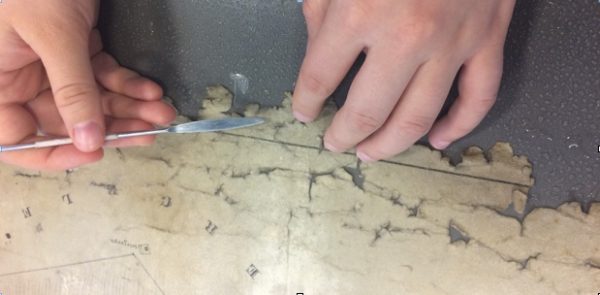Shedding some light – using the Glamorgan Archives lightboard for map conservation
31 January 2017
Devin Mattlin and myself have been volunteering at the Glamorgan Archives for the last 3 months under the guidance of Lydia Stirling. We have been cleaning pamphlets and a leather bound book from the 1800s.
The conservation lab at the archives is a beautiful room with large windows, lots of clean flat working spaces, and an impressive lightboard measuring 3m x 4m. It is said to be the largest single pain of glass in the country, and was imported from Spain. Earlier this month 3 maps were brought in for conservation treatment. Our eyes lit up: we knew we could finally use the light board!

Drying and moisture management is a tricky business with paper conservation. There are various techniques including temporary mounting which keeps the paper under tension, ensuring less distorted pulling in the drying process. This is what the lightboard is used for. The lightboard takes it’s inspiration from the Japanese Karibari board. Briefly, a karibari board is a temporary mount constructed from 8 layers of various paper types on a wooden frame with a persimmon tannin finish. (For more info on a karibari board check out this.)
Every day that we go to the archives, the lightboard is begging to be used, and now was our first time.
Devin and Michael Hodgson (a paper conservator who has been working at the archives for over 20 years) prepared the backing mount on the lightboard. A few days later Devin, myself and Michael proceeded to remove the backing material of the map, wash it, and carefully unfold and untwist its torn edges. Laying the map flat on the lightboard allows the paper to dry in the right placing while we fill in the missing portions with matching repair tissue. It has been mounted on the lightboard with wheat starch paste for about a week, while we complete the infills.



You can find out more about the Glamorgan Archives at their Facebook page, or on Twitter.
- March 2024 (1)
- December 2023 (1)
- November 2023 (2)
- March 2023 (2)
- January 2023 (6)
- November 2022 (1)
- October 2022 (1)
- June 2022 (6)
- January 2022 (8)
- March 2021 (2)
- January 2021 (3)
- June 2020 (1)
- May 2020 (1)
- April 2020 (1)
- March 2020 (4)
- February 2020 (3)
- January 2020 (5)
- November 2019 (1)
- October 2019 (1)
- June 2019 (1)
- April 2019 (2)
- March 2019 (1)
- January 2019 (1)
- August 2018 (2)
- July 2018 (5)
- June 2018 (2)
- May 2018 (3)
- March 2018 (1)
- February 2018 (3)
- January 2018 (1)
- December 2017 (1)
- October 2017 (4)
- September 2017 (1)
- August 2017 (2)
- July 2017 (1)
- June 2017 (3)
- May 2017 (1)
- March 2017 (2)
- February 2017 (1)
- January 2017 (5)
- December 2016 (2)
- November 2016 (2)
- June 2016 (1)
- March 2016 (1)
- December 2015 (1)
- July 2014 (1)
- February 2014 (1)
- January 2014 (4)